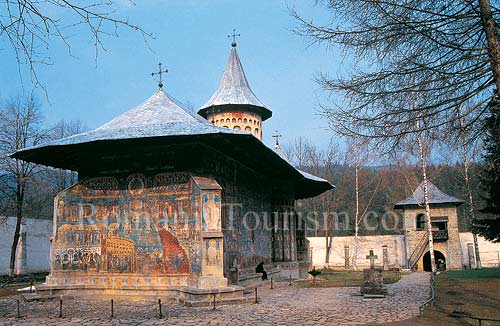The Painted Monasteries of Bucovina
Voronet Monastery
Location: Bucovina – Northeastern Romania
Nearby large town: Suceava (20 miles east)
Access: car, bus (from Gura Humorului), 3 ½-mile walk from Gura Humorului
Nearest train stations: Gura Humorului

Perhaps the most famous and stunning of the painted monasteries is Voronet (Vo ro nets), founded in 1487 by Stephen the Great to celebrate a victory over the Turks. Widely known throughout Europe as "the Sistine Chapel of the East" due to its interior and exterior wall paintings, this monastery offers an abundance of frescoes featuring an intense shade of blue commonly known as ‘Voronet blue.’ The composition of the paint continues to remain a mystery even now, more than 500 years after the church was built.
Added in 1547, the frescoes of this church illustrate biblical scenes, prayers, episodes of sacred hymns and themes such as The Last Judgment and The Ladder of St. John, featuring colorful and detail-rich imagery of apostles, evangelists, philosophers, martyrs, angels and demons.
Monastic life at Voronet was interrupted in 1785 under Habsburg rule. It returned only in 1991 with the arrival of a community of nuns which strives to harmoniously combine a religious life of prayer with housekeeping and farm work. The nuns run a painting workshop and provide guided tours of the monastery for visitors.
Interesting facts:
- Voronet Monastery was founded by Stephen the Great, ruling prince of Moldavia, to fulfill a pledge to Daniil, a hermit who had encouraged him to chase the Turks from Wallachiia. After defeating the Turks, Stephen erected Voronet in less than four months.
- Portraits of ancient Greek philosophers, such as Aristotle and Plato, are featured in the Tree of Jesus fresco.



Please Connect with us